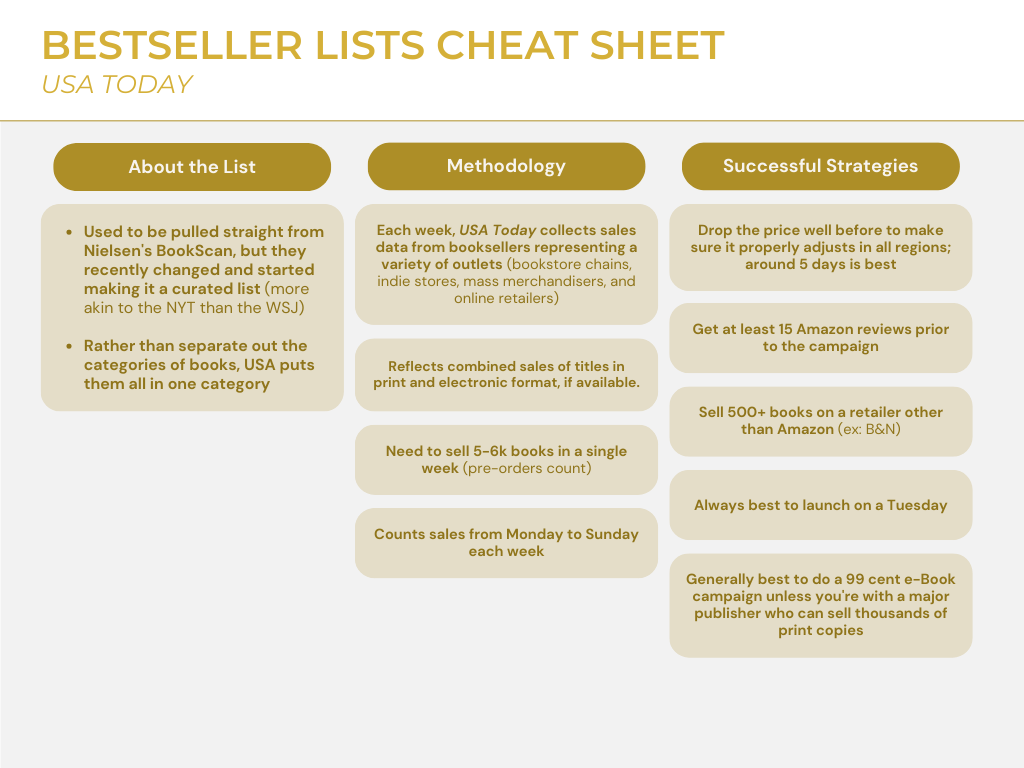Bestseller Series #2: How the Wall Street Journal & USA Today Work
These are probably the fairest bestseller lists out there. They still have their own way of doing things, but for the most part, their sales figures are mostly representative of the larger picture.
Last week, I started a weekly, mini-series covering how some of the major bestseller lists work, including the New York Times, the Wall Street Journal, and even Amazon (which isn’t a bestseller list per se, but it is easy to reach bestseller on it). Keep an eye on your inbox to get the juicy details! 😉
What to Know
The WSJ and USA Today are often lumped together because they both operate very similarly. Both lists are primarily based on sales figures recorded by popular database Circana BookScan (formerly known as Nielsen BookScan). In general, the WSJ is grouped by category and if you reach any slot within the top 10, then you are considered a bestseller. Rankings are updated weekly and, for whatever reason, does not include sales from big box stores like Walmart, Sam’s Club, or Costco.
The cool thing about USA Today is that it tends to be very inclusive of indie book sales as well, not just those that have been traditionally (and/or maybe hybrid) published. There was a period over the past year where it ended due to mass layoffs, and people were not expecting it to return. However, word has come through this year that it is popping back up, which is great!
How It Works
Given this information, the Wall Street Journal bestseller list is informed by two major considerations:
Sales figures produced from Nielsen BookScan, a data provider
How many books are sold in a single category
If we consider the specifics of how a book becomes successful on this list specifically, we’ll need to look at a couple different pre-requisites:
It needs to be a high-quality book. First and foremost. And when I say “high-quality”, I mean it’s understood that it’s been professionally edited and formatted, and has a professionally designed book cover. This is typically done for free in-house at a publisher, assuming the author got a traditional publishing deal. Otherwise, these items can get very expensive very quickly if you’re hybrid or self-publishing. It’s doable, you’ll just have to pay more out-of-pocket.
It needs to sell between 4,000 and 10,000 copies. Though to play it safe, it’s best for an author to shoot for around 7,000-8,000 copies. Although the WSJ does count Amazon purchases, they need to be diversified, meaning they can’t all come from Amazon.
Alternatively, an author can buy their way onto the list. Or rather, they can buy a guaranteed placement on the list. This can cost between $45,000 and $65,000 (or beyond) to do. However, if they do not end up getting a spot on the list, they can expect to get their money back.
Success Tips
To increase your chances of reaching Wall Street Journal bestseller status, consider some of these strategies others have used and documented:
Make sure your book has mass appeal. Nonfiction is typically best for this (e.g. business, self-help…)
Ideally, you’d have sales on Amazon and at least one other platform (e.g. NOOK, Kobo, B&N, etc.)
Get around 15 Amazon reviews prior to the USA Today/WSJ campaign (yes, it is a campaign; you want a concentrated number of high sales in about a week).
Make your book an ebook. Unless you’re with a major publisher who can sell thousands of print copies, eBooks are the easiest to manage in terms of distribution. You’ll need around 6k+ downloads.
Run your promo campaigns over a 7-day period, preferably from a Monday – Sunday.
Use Facebook and Amazon Ads to drive sales. These types of PPC (pay-per-click) ads can be ultra targeted – you can hone in on interests, locations and other demographics.
If you want to get more nitty-gritty info on both bestseller lists, click on the images above to be redirected to two PDF versions where you can zoom in and read more of the details.
Final Thoughts
If you’re wondering if there’s an easier way to become a bestseller, I would do your homework on any program or business claiming to make you one. At best, there are guarantees, but certainly no promises. So much of what is published is also influenced by the market and so much of what makes up the market is influenced by what’s published—a classic case of the chicken and the egg.
Stay tuned for next week’s article on how a book can become an Amazon bestseller!
Thanks for reading! If you found it useful, consider subscribing to this newsletter. Otherwise, follow me on Instagram, @laurenericks0n, where I’m way more active online!





